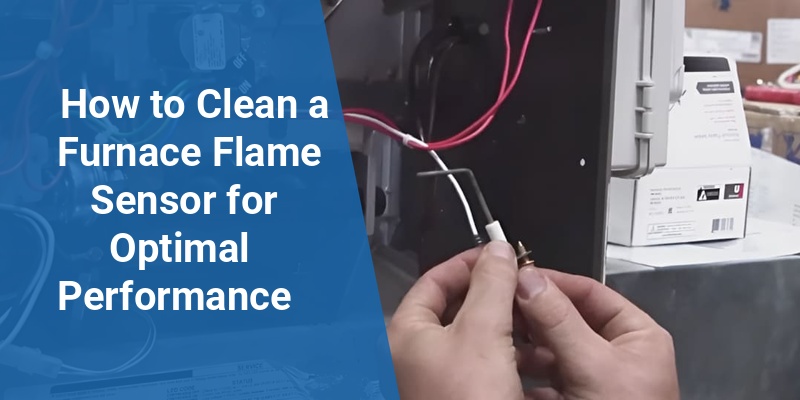Maintaining a clean furnace flame sensor is essential for ensuring your heating system operates safely and efficiently. The flame sensor detects whether the furnace’s burner is lit, preventing dangerous gas leaks by shutting off the gas supply if no flame is present. Over time, dirt and soot can accumulate on the sensor, causing it to malfunction and interfere with your furnace’s operation. This article provides a comprehensive guide on how to clean a furnace flame sensor effectively, tips for troubleshooting, and maintenance recommendations to keep your heating system running smoothly.
| Aspect | Key Points |
|---|---|
| Purpose of Flame Sensor | Detects burner flame to ensure safe furnace operation |
| Signs of Dirty Flame Sensor | Frequent furnace shutdowns, no heat, error codes |
| Cleaning Tools Needed | Fine sandpaper, steel wool, or emery cloth, clean cloth |
| Cleaning Frequency | Annually or as needed based on furnace use |
| Safety Precautions | Turn off power and gas before cleaning |
What Is a Furnace Flame Sensor and Why It Needs Cleaning
The furnace flame sensor is a thin metal rod located inside the burner assembly. Its function is to confirm the presence of a flame whenever the furnace is running. This sensor plays a critical safety role by ensuring the gas valve closes if no flame is detected, preventing unburned gas buildup. Over time, the sensor’s surface can become coated with carbon, dirt, or rust, which impedes its ability to detect the flame properly. A dirty flame sensor causes frequent shutdowns and can lead to higher energy costs and costly repairs.
Common Symptoms of a Dirty or Faulty Flame Sensor
Recognizing when your flame sensor needs cleaning can save time and money. The most common signs include:
- Furnace starts but shuts off after a few seconds: This often indicates the sensor is unable to detect the flame and cuts power as a safety measure.
- Heating intermittently stops: Inconsistent furnace operation may stem from a faulty sensor.
- Error codes on your thermostat or furnace control board: Many modern furnaces will indicate sensor issues.
- No heat despite the furnace running: The burner may ignite but immediately shut down due to sensor failure.
Tools and Materials Needed to Clean a Furnace Flame Sensor
Cleaning a flame sensor requires simple hand tools that are usually available in a household toolbox:
- Fine-grit sandpaper (400-600 grit) or emery cloth: To gently remove build-up without damaging the sensor.
- Non-abrasive steel wool: As an alternative cleaning aid for tough deposits.
- Soft, clean cloth or paper towel: To wipe away residue after sanding.
- Multimeter (optional): To check sensor functionality after cleaning.
- Screwdriver or nut driver: To remove the sensor from the furnace assembly.
- Safety gear: Gloves and safety glasses to protect your hands and eyes during cleaning.
Step-By-Step Guide To Clean Your Furnace Flame Sensor
Turn Off Power and Gas Supply
For safety, always switch off your furnace power at the circuit breaker and close the gas valve before touching any internal parts. This prevents electrical shock or accidental gas leaks.
Locate and Remove the Flame Sensor
The flame sensor is usually mounted on the burner assembly close to the burner flame. Remove any screws or fasteners holding it in place and carefully pull the sensor out. Avoid bending or damaging the sensor rod.
Clean the Flame Sensor Surface
Use fine sandpaper or emery cloth to gently polish the sensor rod, focusing on the metal tip that senses the flame. Rub lightly until all soot and grime are removed and the metal surface shines clean.
Call 888-906-9139 for Free Local HVAC Quotes – No Obligation, Just Savings!
Wipe Down and Inspect
After sanding, use a clean cloth to wipe the sensor and remove any lingering dust. Inspect the sensor for any cracks or damage. If the sensor appears compromised, it should be replaced.
Reinstall the Flame Sensor and Restore Power
Put the clean flame sensor back into its original position and secure it with screws. Turn the gas back on and restore power to the furnace. Monitor your furnace on startup to confirm normal operation.
Troubleshooting Furnace Flame Sensor Issues After Cleaning
Sometimes cleaning may not fully resolve sensor issues. Common troubleshooting steps include:
- Check Sensor Connection: Ensure wiring and connectors to the flame sensor are tight and corrosion-free.
- Test Sensor Resistance: Use a multimeter to measure resistance; an out-of-range reading suggests sensor failure.
- Inspect Furnace Flame: A weak or irregular flame shape can affect sensor operation and may indicate burner issues.
- Schedule Professional Inspection: Persistent sensor problems may require a licensed HVAC technician to evaluate the furnace system.
Preventive Maintenance Tips to Keep Your Flame Sensor Clean
Proactive care can extend your furnace sensor’s life and improve heating efficiency:
- Annual Cleaning: Clean the flame sensor during regular furnace tune-ups at the start of heating season.
- Replace Air Filters Regularly: Dirty filters contribute to soot buildup, impacting sensor cleanliness.
- Inspect Burner Assembly: Clean burners reduce residue that affects the flame sensor.
- Seal Duct Leaks: Proper airflow reduces incomplete combustion and buildup on sensor parts.
- Use High-Quality Fuel: Contaminant-free fuel minimizes deposits on the sensor.
When to Replace Your Furnace Flame Sensor
Flame sensors are durable but not impervious to wear and damage. Signs that replacement is necessary include:
- Visible corrosion or pitting on the sensor surface.
- Cracks or bends in the sensor rod.
- Repeated sensor failure despite cleaning and troubleshooting.
- Sensor resistance tests outside manufacturer specifications.
Replacing a flame sensor is a simple and affordable repair often recommended by HVAC professionals to restore safe furnace operation.
